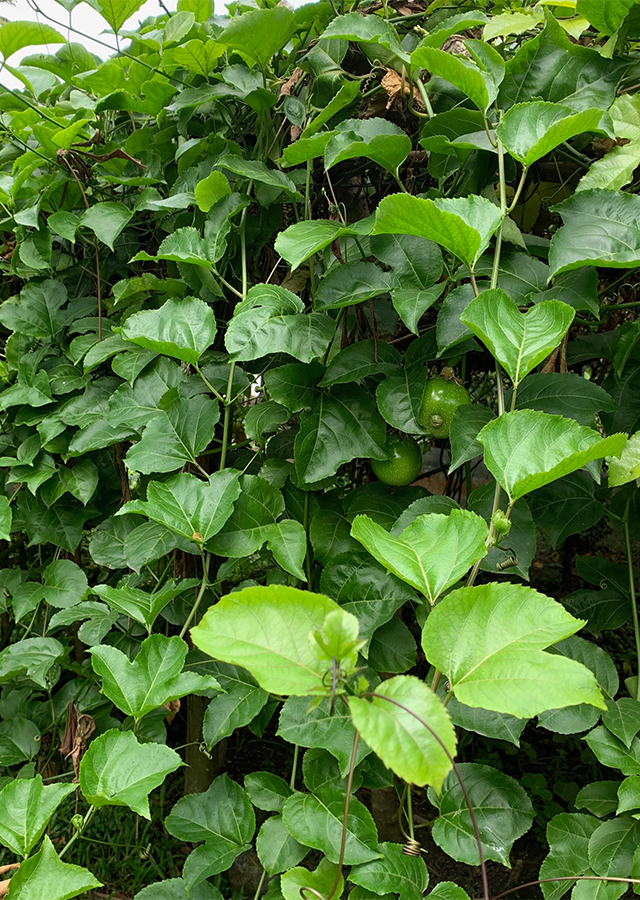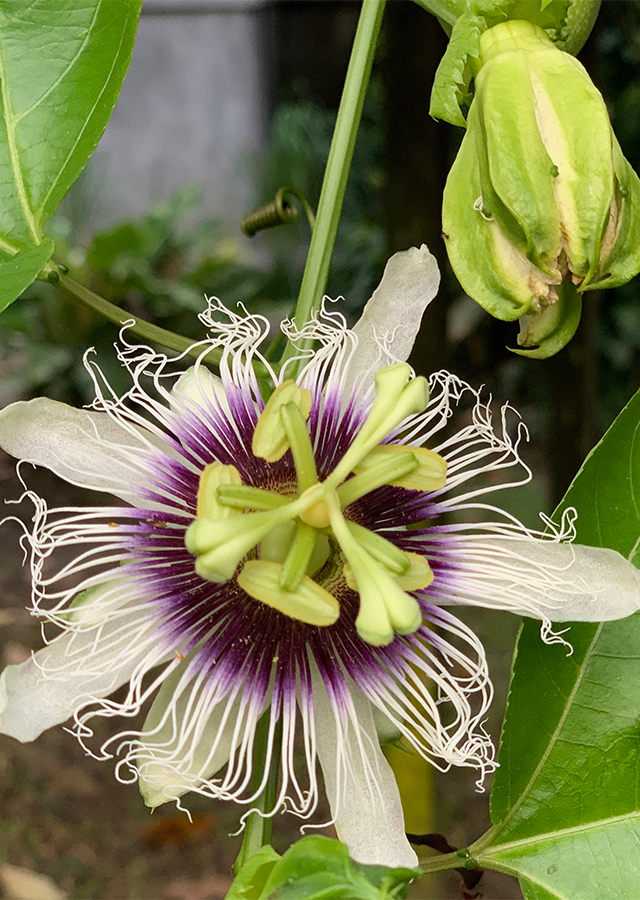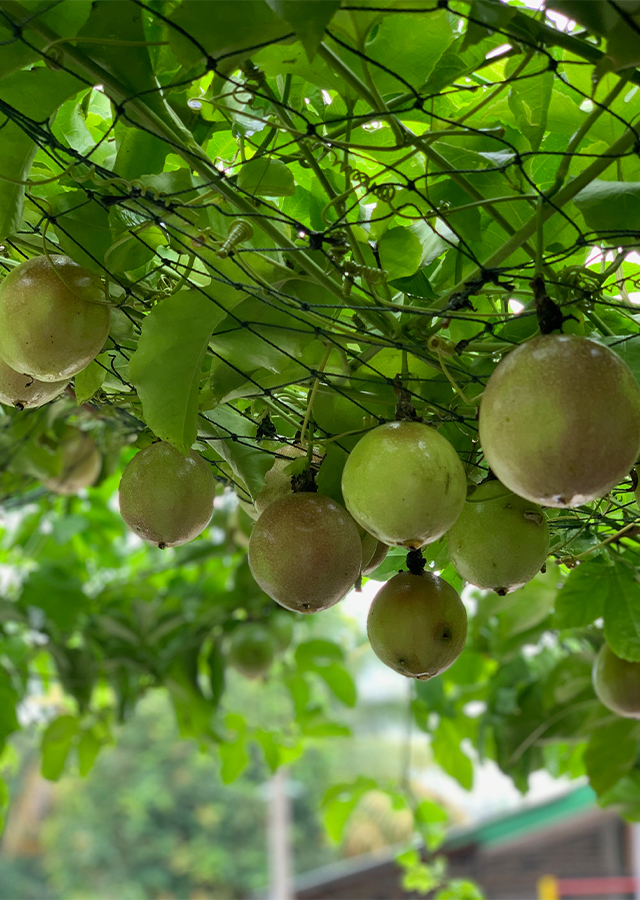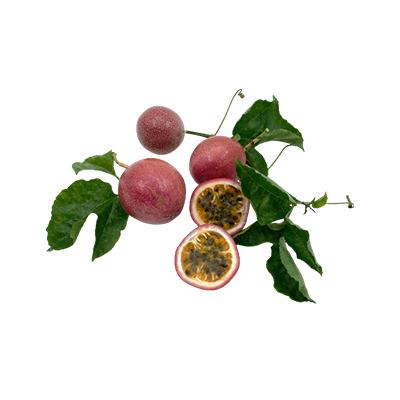Passion Fruit
Passiflora edulis Sims.
Passifloraceae
Location in our garden
Principal



Synonym
Passiflora cuneifolia Cav.
Passiflora diaden Vell.
Passiflora edulis var. pomifera (M.Roem.) Mast.
Habitus
Climbers. A cosmopolitan herbaceous vine, attaining 15 m in length and climbing by means of axillary tendrils. However, it is a short-lived plant.
Part Used
Leaves
Flowers
Fruit
Roots
Growing Requirements
Need Shade
Habitat
Forest
Overview
It is native to South America (Argentina Northeast, Brazil Northeast, Brazil South, Brazil Southeast, Brazil West-Central, Paraguay). Passion fruit is listed as invasive in many tropical areas. It is naturalized and spreading but usually regarded as a minor weed in most areas where it is introduced e.g. Australia and Africa. As with many weedy crop species, its invasiveness may be under-reported because of its useful qualities.
Vernacular Names
Buah negeri, Pasi (Indonesia), Buah susu (Malaysia), Pasionaria (Philippines), Granadiglia (Italy), Linmangkon (Thailand), Linmangkon (Laos), Chùm bap (Vietnam), Grenadille (Fr).
Agroecology
P. edulis grew at lower elevations in tropical areas. It can be grown between sea level and 900 m in the subtropics, and from 900-2,000 m or even higher in the tropics. It grows best in areas where annual daytime temperatures are within the range 20-30 °C, but can tolerate 18-34 °C. It grows on a variety of soils; thick clay soils must be drained, and sandy soils require a lot of manure. A pH of 6 to 8 is ideal.
Morphology
- Stems - slender, angular, striate, glabrous, or puberulent. Have a tendril located axillary and longer than the leaves.
- Leaves - stipules 1 cm long; petiole 2-5 cm long, glabrous, grooved above, 2 circular glands at the top; blades unlobed when young, palmately 3-lobed, cordate at base; lobes ovate-oblong, 10-15 cm x 12-25 cm, acuminate, edge with curved teeth that are glandular tipped
- Flowers - axillary, in pairs; the bracts subulate, not forming an involucre; peduncle ca. 10 mm long, articulated near the apex. Colored white-purple-based.
- Fruits - round to oval, yellow or dark purple at maturity, with a soft to firm, juicy interior filled with numerous seeds.
- Seeds - numerous, elliptical, approximately 2.3 mm long, with transverse striae, covered with edible arils colored yellowish.
Cultivation
- Propagated by seed - best sown as soon as it is ripe along with the pulp which will help break down the seed coat and speed up germination.
- Propagation also could be done by cutting or grafting methods.
Chemical Constituents
Protein, fat, carbohydrates, Ca, Mg, Fe, vitamin A, trace thiamine, riboflavin, nicotinamide, carotenoids, sulforaphanes, alkaloids, triterpenoids, flavonoids, vitamin C, and also volatile compounds.
Traditional Medicinal Uses
- Studies have suggested antioxidant, anti-inflammatory, antiproliferative, anxiolytic, hypnotic, antibacterial, analgesic, anticonvulsant, anti-sickling, antihypertensive properties.
- The Cherokee (Oklahoma, USA) used the roots as a poultice to draw out inflammation in thorn wounds; tea of the root in the ear for earache and to wean infants.
- The Houma people (Louisiana, USA) infused the roots as a blood tonic. Practitioners actually use the plant extracts alone or in combination with other herbal medicines to treat depression and insomnia in a wide range of patients.
- Used as an ethnic remedy for the cure of numerous infectious disorders of bacterial, fungal, viral, mycobacterium, and protozoal origin.
- Used in the treatment of anxiety and sleep disorders.
Part Used
Reference Sources
- Gurnah, A.M. 1992. Passiflora edulis. In E.W.M. Verheij and R.E. Coronel (Eds). Plant Resources of Southeast Asia No.2. Edible Fruits and Nuts. Prosea Foundation. Bogor.
- Invasive Species Compendium. 2014. Passiflora edulis. https://www.cabi.org/isc/datasheet/38799#tosummaryOfInvasiveness.
- Plant of The World Online. 2021. Passiflora edulis. https://powo.science.kew.org/taxon/urn:lsid:ipni.org:names:321964-2.
- He, X., Luan, F., Yang, Y., Wang, Z., Zhao, Z., Fang, J., Wang, M., Zuo, M., and Li, Y. 2020. Passiflora edulis: An Insight Into Current Researches on Phytochemistry and Pharmacology. Front Pharmacol. 11: 617. doi: 10.3389/fphar.2020.00617.



